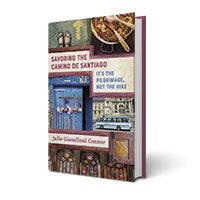
Alumni Books: Q&A with Julie Gianelloni Connor
By Jennifer Latson

Savoring the Camino de Santiago: It’s the Pilgrimage, Not the Hike
Julie Gianelloni Connor ’73
Bayou City Press, 2020
Seekers of spiritual enlightenment have walked Spain’s Camino de Santiago for centuries, starting with the millions of medieval Catholics who undertook the pilgrimage as penance for their sins, ensuring that they’d spend less time in purgatory. The roughly 500-mile journey is a sort of purgatory in itself, but that doesn’t stop hundreds of thousands of modern-day pilgrims from following in their footsteps every year. Julie Gianelloni Connor, a retired foreign service officer and the founder of Houston’s Bayou City Press, is one; she writes about her experience in her book, “Savoring the Camino de Santiago.” We spoke with her about what put her on the path and what she took away.
Q. You spent 40 years thinking about making the trek. What took you so long?
A. When I first heard about the Camino, I was in my early 20s and teaching English in Portugal. I barely made enough money to feed myself, so taking a long trip was just not a possibility. I kept thinking about it, though, and always thought that I would travel the Camino after retirement. I originally planned to drive the French route, but between 1970 and 2014 when I retired, walking the Camino exploded in popularity, and gradually I was persuaded that walking the Camino was the way to experience it.

Q. How did you prepare for the trip?
A. I read a lot of books by others who had traveled the Camino. That’s my usual way to prep for a trip. I researched the gear I would need, but I didn’t actually train, which I should have. Going up and down all those hills and mountains in northern Spain is a challenge for a flatlander like me.
Q. What did you take away from the experience?
A. At the end of my trip I thought that I must be a very shallow, superficial person because I didn’t experience any of the life-altering moments other pilgrims wrote about. Once back at home, however, I had time to reflect. The war-torn Middle East was spawning migration disasters all through the Mediterranean, and here at home our immigration policies seemed to me to be headed in the wrong direction. When I thought about the everyday help I, as a foreigner, received from Spaniards all along the Camino, I began to believe that being on the receiving end of unexpected kindness was an important experience. A handful of almonds given to me by a total stranger told me something about the value of offering a helping hand to others. I try to keep this lesson in mind all the time.
Q. What advice do you have for others who are contemplating the pilgrimage?
A. I think the most important thing to keep in mind is that there is no “right” way to experience the Camino. The important thing is just to go do it. You can do a long walk here in the U.S. via the Pacific Crest or Appalachian trails, but you won’t have an experience at all like you do on the Camino. My heart would swell when I stood on sections of the Roman Road or on the bridge at Puente La Reina and reflected that my footsteps followed those of millions of others, dating back to the ninth century when pilgrims first set out for Santiago de Compostela.
